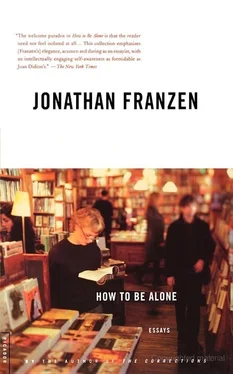I have no objection to a nice bra, still less to being invited to remove one. But brothelwear of the kind sold at Frederick’s of Hollywood seems to me scarcely less hokey than a Super Bowl halftime show. What I feel when I hear that the mainstream actually buys this stuff is the same garden-variety alienation I feel on learning that Hootie & the Blowfish sold thirteen million copies of their first record, or that the American male’s dream date is Cindy Crawford. In a sense, I’m proud of not being like everybody else. Like everybody else, though, I’m anxious about sex, and with sex the recognition that I’m not like everybody else leads directly to the worry that I’m not as good as — or, at any rate, not having as much fun as — everybody else.
Sexual anxiety is primal; physical love has always carried the risk that one’s most naked self will be rejected. If Americans today are especially anxious, the consensus seems to be that it’s because of “changing sex roles” and “media images of sex” and so forth. In fact, we’re simply experiencing the anxiety of a free market. Contraception and the ease of divorce have removed the fetters from the economy of sex, and, like the citizens of present-day Dresden and Leipzig, we all want to believe we’re better off under a regime in which even the poorest man can dream of wealth. But as the old walls of repression tumble down, many Americans — discarded first wives, who are like the workers displaced from a Trabant factory; or sexually inept men, who are the equivalent of command-economy bureaucrats — have grown nostalgic for the old state monopolies. What are The Rules if not an attempt to reregulate an economy run scarily amok?
Until the Rules become universal, though, such comfort as can be found in the market economy comes principally from norms. Are you worried about the size of your penis? According to Sex: A Man’s Guide , most men’s erections are between five and seven inches long. Worried about the architecture of your clitoris? According to Betty Dodson, in the revised edition of her Sex for One: The Joy of Selfloving , the variations are “astounding.” Worried about frequency? “Americans do not have a secret life of abundant sex,” the researchers of Sex in America concluded. Worried about how long it takes you to come? On average, says Sydney Barrows, it takes a woman eighteen minutes, a man just three.
The problem with relying on norms for comfort, however, is not only that you may fail to meet them but that you may meet them all too well. Who really wants to be sexually just like everybody else? Isn’t the bedroom where I expect, rather, to feel special? Unique, even? The last thing I want is to be reminded of the vaguely icky fact that across the country millions of other people are having sex. This is the conundrum of the individual confronting masses about which he can’t help knowing more than he’d like to know: I want to be alone, but not too alone. I want to be the same but different.
POPULAR SEX BOOKS are only a part of the sex industry, but one could argue that they’re the most representative wing, in that they are books. If a sexual fetish is understood as a displacement of genital energies, then language, even more than lingerie, is by far the most prevalent paraphilia in the country today. You can’t show a bare breast on network television, but there’s no limit to the backdoor prurience of talk about rape, incest, and sexual harassment. Cybersex and phone sex are vastly more popular ways of avoiding intimate fluids than is the worship of, say, knees or feet.
Although our pop sex writers seem to recognize the ascendance of language, they don’t trust their readers to know how, or even when, to use it. In Sex: A Man’s Guide we learn that lovers can be encouraged to talk dirty by making lists of “clinical” and “dirty” terms and comparing them. Dr. Block reels off forty-five possible pet names for a penis, including “peenie-weenie,” “dipstick,” and “lovepump,” and commands her readers: “Take your pick.” (More adventurous souls are urged to “make up something special” to suit their “very special wonder worm.”) Susan Bakos cues Tantric lovers to the appropriate moment for “whispered terms of endearment,” and she suggests that women who want to learn to talk dirty rent some video porn and study it carefully. “Once you are comfortable saying the words as a scriptwriter wrote them,” she tells us, “you can personalize them to make it sound more like you speaking.”
Reading a book of expert sexual instruction must rank near the bottom on the scale of erotic pastimes — somewhere below peeling an orange, not far above flossing. One problem is that, although the intention is precisely the opposite, these books collectively and individually make the world of sex seem very small. Never mind that there are only so many ways to fit body parts together or that Alex Comfort has already said and said well, in works that have sold better than eight million copies, pretty much all there is to say about it. There seems, in general, to be far too little lore to go around. Author after author derives the etymology of “cunnilingus,” stresses the importance of doing “kegel” exercises to strengthen the pubococcygeal muscles, and quotes Shakespeare on the topic of alcohol. (“It provokes the desire, but takes away the performance.”) Author after author insists that men are “visual creatures” and that the size of a penis matters less than what its owner does with it. When the lore runs out, the advice turns bleakly otiose. Dr. Susan Block commands lovers: “Use babytalk, or at least ‘pet names.’” In Sexational Secrets , whose subtitle promises “exotic advice your mother never told you,” Susan Bakos instructs masturbating men to use, “in various combinations,” the Slow Single Stroke, the Fast Single Stroke, the Slow Two-Hand Stroke, the Fast Two-Hand Stroke, the Cupped Hand, the Finger Stroke, the Wrist Pump, the Slap, the Beat, the Rub, the Squeeze Stroke, the Open-Hand Stroke, and the Vagina Simulator Stroke; instructions for each are provided.
The italicized cheerfulness with which pop-sex authors convey the useless and the banal is identical to that of the newscasters on airport.TV, whose most striking talent is the ability to summon (or to fake, like an orgasm) fresh wonderment over the latest wrinkle in automobile safety. Trying to make fascinating and new what is neither, the authors tirelessly coin neologisms. They toss off “sexation,” “prime-mate,” “soulgasm,” and “partnersex” with the supreme self-assurance that American audiences now demand from professional exhibitionists. Dr. Block, who calls herself an “erotic philosopher,” illustrates her commandments with glimpses of her husband and herself in bed: “Max grunts like a bonobo chimp when he wants to go down on me, then moans and coos and tells me I’m delicious as he slurps away.” For people who have never shared a fantasy with their lovers but “would like to try,” the philosopher has this advice: “Watch the Dr. Susan Block Show together — that’ll stimulate your fantasies!”
Not every pop-sex book points to television quite this literally, but all the books seem bent on enmeshing sex (formerly life’s one free pleasure) in the web of consumer spending. The reader is relentlessly exhorted to buy erotic videos, high-quality lingerie, candles, champagne, incense, oils, vibrators, perfumes, bath-bubble mix. Betty Dodson, Ph.D., sounds less like a prophet of an autoerotic utopia than like an infomercial host; she twice gives readers an address from which her videos may be ordered. Sydney Barrows suggests that renting luxury cars, wearing full-length fur coats, and taking expensive vacations will spice up the deadliest marriage. In Sexational Secrets , Susan Bakos sets out to gather for the presumably impecunious reader the rarefied sexual know-how that members of the moneyed classes spend thousands to obtain. Apparently, the best sex is being had today by a lucky international elite who can afford $625 for multiple-orgasm workshops. Whether Bakos is interviewing “beautiful French courtesans” or a master of Kundalini yoga, she goes out of her way to stress the demographics of their clientele. They are “sheiks,” they live in “secluded” suburban homes, they wear “business suits” and drink “flavored coffees.”
Читать дальше
Конец ознакомительного отрывка
Купить книгу












